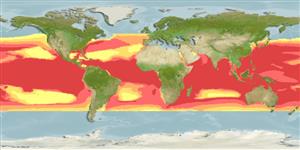Preferred temperature (ссылка
123201): 18.2 - 27.7, mean 25.6 °C (based on 513 cells).
Phylogenetic diversity index (ссылка
82804): PD
50 = 0.7505 [Uniqueness, from 0.5 = low to 2.0 = high].
Bayesian length-weight: a=0.00589 (0.00273 - 0.01268), b=3.14 (2.94 - 3.34), in cm total length, based on LWR estimates for this species & (Sub)family-body (Ref.
93245).
Trophic level (ссылка
69278): 4.5 ±0.3 se; based on diet studies.
устойчивость к внешним воздействиям (ссылка
120179): низкий, минимальное время удвоения популяции 4.5-14 лет (rm=0.11; K=0.1-0.8; tmax=13; Fec=>2M).
Prior r = 0.38, 95% CL = 0.25 - 0.57, Based on 1 full stock assessment.
Fishing Vulnerability (Ref.
59153): Moderate vulnerability (41 of 100).
🛈
Climate Vulnerability (Ref.
125649): Moderate to high vulnerability (48 of 100).
🛈
Nutrients (Ref.
124155): Calcium = 26.2 [12.9, 42.4] mg/100g; Iron = 0.856 [0.511, 1.406] mg/100g; Protein = 19.6 [18.4, 20.6] %; Omega3 = 0.209 [0.114, 0.374] g/100g; Selenium = 44.7 [23.7, 83.1] μg/100g; VitaminA = 6.44 [2.15, 18.92] μg/100g; Zinc = 0.364 [0.257, 0.521] mg/100g (wet weight);
